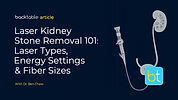BackTable / Urology / Podcast / Episode #152
Laser Options for Kidney Stones: A Clinician’s Guide
with Dr. Ben Chew
This week on BackTable Urology, Dr. Ben Chew, professor and clinical researcher with the University of British Columbia, provides valuable insights on laser treatments for kidney stones.
Be part of the conversation. Put your sponsored messaging on this episode. Learn how.

BackTable, LLC (Producer). (2024, February 20). Ep. 152 – Laser Options for Kidney Stones: A Clinician’s Guide [Audio podcast]. Retrieved from https://www.backtable.com
Stay Up To Date
Follow:
Subscribe:
Sign Up:
Podcast Contributors
Dr. Ben Chew
Dr. Ben Chew is a urologist at University of Britich Columbia and the chair of research of the Endourology Society.
Dr. Jose Silva
Dr. Jose Silva is a board certified urologist practicing in Central Florida.
Synopsis
First, Dr. Chew provides a comprehensive overview of the current landscape of laser treatment for kidney stones. Dr. Silva and Dr. Chew then discuss the unique characteristics of different laser types, such as the Holmium and the Thulium lasers. Dr. Chew also covers critical safety considerations, like maintaining low intravenous pressure, using cold irrigation, and taking breaks during sustained laser treatment. Additionally, they delve into emerging technology, such as the use of electromagnetic guidance, for more accurate laser application.
Timestamps
00:00 - Introduction
06:49 - Choosing the Right Laser
12:11 - Energy Settings for Lasers
18:49 - Upper Tract Tumors and Lasers
23:54 - Preventing Thermal Injuries During Laser Treatment
27:03 - Dusting vs Fragmentation with Lasers
34:27 - The Impact of New Technologies on Kidney Stone Treatment
41:30 - Final Thoughts and Safety Recommendations
Transcript Preview
[Dr. Ben Chew]
There's the Holmium YAG, which is still the proven gold standard, probably the most popular one across the world, made by multiple different companies. It's the tried and true that we've had. The newer ones that have come out, the reason why the Holmium YAG, they first had to develop pulse lasers. When it was continuous, it would just generate so much heat, it would basically damage the kidney.
It wasn't until they could pulse the lasers that they could use it clinically. Once they developed that, they found that it fragmented stones really well. This is still the go-to in many, many different places. Now the second laser that I used was only a few years ago, and that was a thulium fiber laser. With that, when the engineers come to the OR, I think this is when we really bridge the gap because we as urologists, we're really problem solvers and we know how to troubleshoot.
Disclaimer: The Materials available on BackTable.com are for informational and educational purposes only and are not a substitute for the professional judgment of a healthcare professional in diagnosing and treating patients. The opinions expressed by participants of the BackTable Podcast belong solely to the participants, and do not necessarily reflect the views of BackTable.













